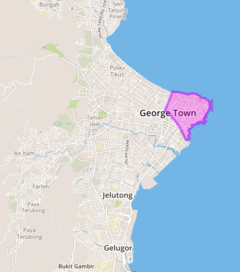
Francis Light was a British Royal Navy officer and explorer best known for founding the colony of Penang and its capital city of George Town in 1786. Light was the father of William Light, who founded the city of Adelaide in South Australia in 1836.

The Cheong Fatt Tze Mansion is a government gazetted heritage building located on Leith Street in George Town, Penang, Malaysia. The mansion's external decorations and indigo-blue outer walls make it a very distinctive building, and it is sometimes referred to as The Blue Mansion. Built by the merchant Cheong Fatt Tze at the end of the 19th century, the mansion has 38 rooms, 5 granite-paved courtyards, 7 staircases and 220 vernacular timber louvre windows. It served as Cheong's private residence as well as the seat of his business activities in Penang.

Penang Hill is a hill resort comprising a group of peaks near the center of Penang Island, Malaysia. It is located within the Air Itam suburb, 9 km (5.6 mi) west of the center of George Town. Penang Hill is also known by the Malay name Bukit Bendera, which actually refers to Flagstaff Hill, the most developed peak. One of the peaks is known as Strawberry Hill, which was also the name of a house owned by Francis Light, founder of Penang colony.

St. Xavier's Institution, at Farquhar Street in George Town, Penang, Malaysia, is the oldest Lasallian school in Southeast Asia and one of the Catholic Lasallian schools in Malaysia. While it has a history dating back to 1787, the present-day institution, named after St. Francis Xavier, was only established in 1852.

The Carcosa Seri Negara is a residence located on two adjacent hills inside the Perdana Botanical Gardens, Kuala Lumpur, Malaysia. Originally built as the official residence and guest house of the British High Commissioner in Malaya, it is now owned by the Government of Malaysia. The name is a composite of the two colonial mansions located on the compound: the residence, named Carcosa, and the guest house, now named Seri Negara (1913).

Methodist Boys' School is an all-boys secondary school in George Town, Penang, Malaysia. It is one of the two secondary schools in George Town that were established by Methodists, the other being Methodist Girls' School.

The Penang State Assembly Building is the home of the Penang State Legislative Assembly. It is located at Light Street in the city of George Town in Penang, Malaysia, within the city's UNESCO World Heritage Site. All State Legislative Assembly proceedings are held within the building.

The architecture of Penang reflects the 171 years of British presence on the island, coalescing with local, Chinese, Indian, Islamic and other elements to create a unique and distinctive brand of architecture. Along with Malacca, Penang is an architectural gem of Malaysia and Southeast Asia. Unlike Singapore, also a Straits Settlement, where many heritage buildings had to make way for modern skyscrapers and high-rise apartments due to rapid development and acute land scarcity, Penang's architectural heritage has enjoyed a better fate. Penang has one of the largest collections of pre-war buildings in Southeast Asia. This is for the most part due to the Rent Control Act which froze house rental prices for decades, making redevelopment unprofitable. With the repeal of this act in 2000 however, property prices skyrocketed and development has begun to encroach upon these buildings, many of which are in a regrettable state of disrepair. The government in recent years has allocated more funding to finance the restoration of a number of derelict heritage buildings, most notably Suffolk House, City Hall and historic buildings in the old commercial district.

Ayer Itam is a suburb of George Town in the Malaysian state of Penang. Nested within the central valleys of Penang Island, it is located approximately 6 km (3.7 mi) southwest of the city centre. The suburb is home to Kek Lok Si, touted as the largest Buddhist temple in the country.

St. George's Church is a 19th-century Anglican church within George Town in the Malaysian state of Penang. The oldest purpose-built Anglican church in Southeast Asia, it was elevated by to the status of pro-cathedral in 2023. The church lies within the jurisdiction of the Upper North Archedeaconry of the Anglican Diocese of West Malaysia.

The Residency is the official residence of Penang's head of state, the governor of Penang. Located in the state's capital city of George Town, it was built by the British in 1888 and the mansion used to serve as the official residence of the highest-ranking British officer in Penang until Malayan independence in 1957.
Cheah Tek Soon was a 19th-century Penang businessman, and headman of the Hokkien in Penang, after whom Tek Soon Street was named. He was an active member of the Penang community and the bandstand that was erected near the Town Hall before the Japanese Occupation was his gift to the city.

George Caunter was a British administrator who governed Prince of Wales Island as Acting Superintendent from 1797 to 1798 and again from 1798 to 1800. As First Assistant under Lieutenant-Governor Leith he negotiated the treaty that brought Province Wellesley under British sovereignty in 1800 and that provided, in British eyes, an unequivocal basis for British sovereignty over Penang Island. At various times Caunter further held the offices of marine storekeeper, master attendant, Chief Magistrate, Treasurer and Chaplain in Penang.

The Penang Botanic Gardens is a botanical garden within the city of George Town in the Malaysian state of Penang. Situated at Jalan Air Terjun, it is also colloquially known as the Waterfall Gardens because of the cascading waterfall nearby.

Beach Street is a major thoroughfare in George Town within the Malaysian state of Penang. Part of the city's central business district, it is also one of the oldest streets in Penang, having been created soon after the founding of the state by Captain Francis Light in 1786.

Light Street is the oldest road in the city of George Town within the Malaysian state of Penang. It was named after the founder of Penang, Captain Francis Light. As the epicentre of George Town, the street was created soon after Light established the settlement in 1786 and has been serving as a major thoroughfare within the city centre ever since.

Farquhar Street is a major thoroughfare in the city of George Town within the Malaysian state of Penang. Created in the late 18th century, the road forms part of the city centre's civic precinct, and is notable for the colonial buildings built under British rule. These include some of the most significant civic, religious, and commercial buildings of Penang, such as Penang High Court, Penang State Museum and Art Gallery, St. George's Church, Church of the Assumption, and Eastern & Oriental Hotel.

The Seri Teratai is the official residence of Penang's head of government, the Chief Minister of Penang. It is located in the city of George Town in Penang, Malaysia. The colonial-era double storey mansion was constructed in the early 20th century.

























